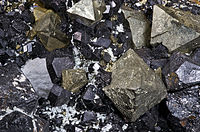
Photo from wikipedia
We report a simple process for the synthesis of Fe3O4@SiO2/APTMS (APTMS = 3-aminopropyltrimethoxysilane) core–shell nanocatalyst support. The new nanocatalyst was prepared by stabilization of Pd(cdha)2 (cdha = bis(2-chloro-3,4-dihydroxyacetophenone)) on the surface of the Fe3O4@SiO2/APTMS… Click to show full abstract
We report a simple process for the synthesis of Fe3O4@SiO2/APTMS (APTMS = 3-aminopropyltrimethoxysilane) core–shell nanocatalyst support. The new nanocatalyst was prepared by stabilization of Pd(cdha)2 (cdha = bis(2-chloro-3,4-dihydroxyacetophenone)) on the surface of the Fe3O4@SiO2/APTMS support. The structure and composition of this catalyst were characterized using various techniques. An efficient method was developed for the synthesis of a wide variety of biaryl compounds via fluoride-free Hiyama cross-coupling reactions of aryl halides with arylsiloxane, with Fe3O4@SiO2/APTMS/Pd(cdha)2 as the catalyst under reaction conditions. This methodology can be performed at 100°C through a simple one-pot operation using in situ generated palladium nanoparticles. High catalytic activity, quick separation of catalyst from products using an external magnetic field and use of water as green solvent are attributes of this protocol.
Journal Title: Applied Organometallic Chemistry
Year Published: 2018
Link to full text (if available)
Share on Social Media: Sign Up to like & get
recommendations!